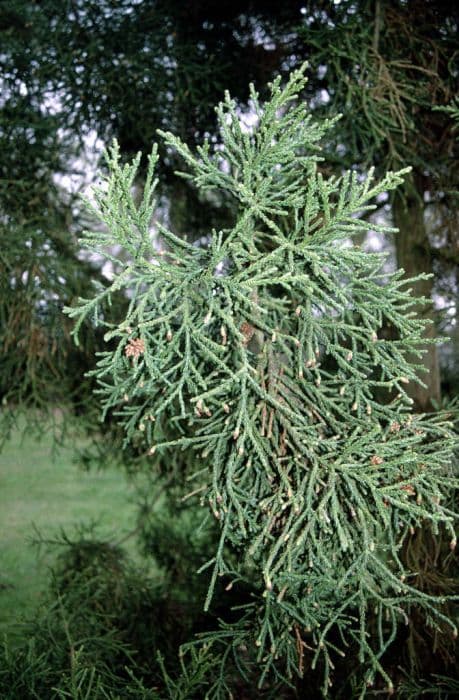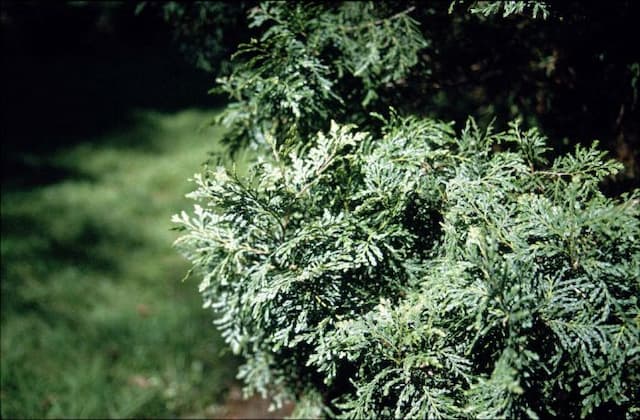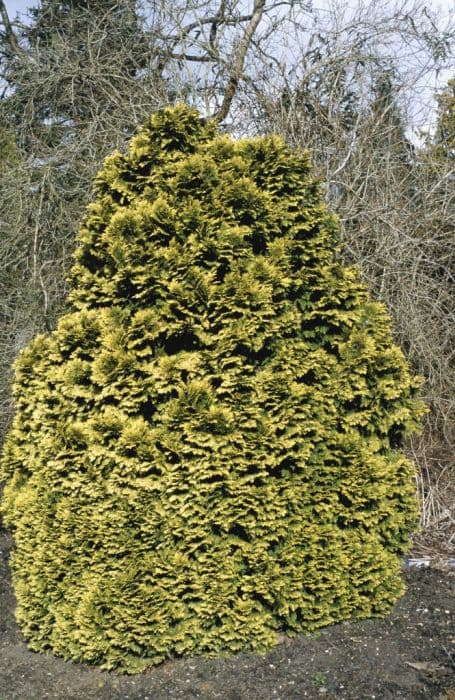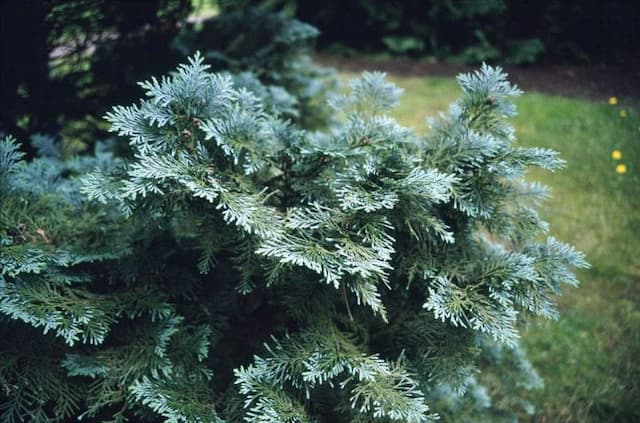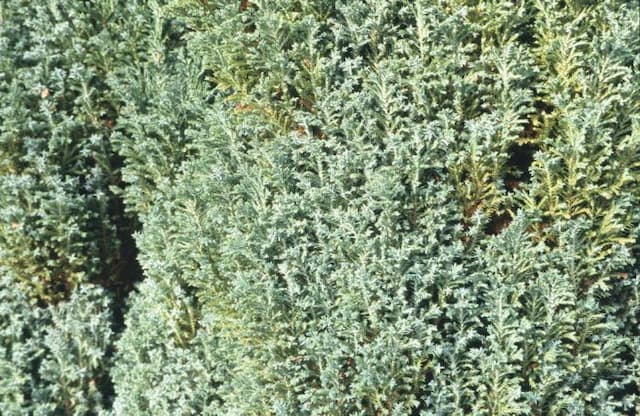Lawson's Cypress Snow White Chamaecyparis lawsoniana 'Snow White' (v)










ABOUT
The plant known commonly as 'Snow White' Lawson Cypress is an attractive evergreen with a distinctive appearance. The foliage is lush and primarily a deep green color, which serves as a backdrop for the creamy white tips of the new growth, giving the plant a speckled 'snow-dusted' look. As the seasons change, the white tips can become more prominent, enhancing the contrast against the dark green older foliage. The plant develops a conical shape with dense, soft, feathery sprays of foliage that can provide year-round interest in gardens. The overall effect is a striking variegated pattern that catches the eye, making the 'Snow White' Lawson Cypress a popular choice for adding texture and variegation to the landscape. The needles are small and scale-like, closely hugging the stems, contributing to the plant's fine texture. The branches grow in a somewhat horizontal fashion but with a slight upward sweep, adding to the plant’s elegant structure. The overall visual appeal of the plant lies in its color contrast and soft, fluffy appearance, reminiscent of a winter landscape.
About this plant
 Names
NamesFamily
Cupressaceae.
Synonyms
Lawson's Cypress, Port Orford Cedar, White Cedar.
Common names
Chamaecyparis lawsoniana 'Snow White' (v).
 Toxicity
ToxicityTo humans
Lawson's Cypress 'Snow White' is not generally known for being toxic to humans. However, some individuals may experience skin irritation or allergic reactions upon handling the plant. If ingested, it is not typically considered poisonous, but consuming parts of the plant is not advised as it may cause gastrointestinal discomfort or other non-specific symptoms.
To pets
Lawson's Cypress 'Snow White' is also not known to be highly toxic to pets. Similar to humans, the plant could cause mild gastrointestinal upset if ingested by animals like cats or dogs. Pets may also experience skin irritation if they come into contact with the plant’s sap. It is always best to prevent pets from chewing on or ingesting plants, as individual reactions can vary.
 Characteristics
CharacteristicsLife cycle
Perennials
Foliage type
Evergreen
Color of leaves
Variegated
Height
6 feet (1.8 meters)
Spread
3 feet (0.9 meters)
Plant type
Tree
Hardiness zones
5
Native area
North America
Benefits
 General Benefits
General Benefits- Aesthetic Appeal: The 'Snow White' Lawson Cypress adds visual interest to gardens with its white-tipped foliage and pyramidal form.
- Low Maintenance: Once established, it requires minimal upkeep, making it ideal for gardens where maintenance time is a concern.
- Drought Tolerance: It is relatively drought-resistant, reducing the need for frequent watering after it has been acclimated.
- Cold Hardy: It can withstand colder temperatures, making it suitable for planting in many temperate regions.
- Erosion Control: It can be used on slopes and banks to help prevent soil erosion.
- Habitat Support: Provides shelter and nesting sites for birds and other wildlife.
- Year-Round Interest: Evergreen nature ensures that the landscape remains green and vibrant even during winter months.
- Privacy Screen: With its dense foliage, it makes an effective natural privacy barrier.
- Windbreak: Can serve as a windbreak when planted in rows or groupings, protecting gardens and homes from strong winds.
- Versatility in Landscaping: Suitable for use in various design styles, including formal gardens, rock gardens, and as foundation plantings or hedges.
 Medical Properties
Medical PropertiesThis plant is not used for medical purposes.
 Air-purifying Qualities
Air-purifying QualitiesThis plant is not specifically known for air purifying qualities.
 Other Uses
Other Uses- Miniature Garden Accent: 'Snow White' is commonly used to add a touch of evergreen beauty in very small or miniature gardens, providing year-round interest without overwhelming the space.
- Bonsai Material: Due to its compact growth habit, it can be trained as a bonsai, offering hobbyists a beautiful coniferous option for their collection.
- Wildlife Refuge: The dense foliage provides shelter and nesting sites for small birds and beneficial insects.
- Photography Prop: Its distinct frosty appearance is often used by photographers as a backdrop for winter-themed shoots or to add texture to garden photography.
- Fairy Gardens: This dwarf conifer works wonderfully in creating fairy gardens, providing a realistic tree-like structure that fits the scale of such projects.
- Culinary Garnish: While not commonly known, the sprigs can be used as a non-toxic garnish for cold dishes; however, it's crucial to ensure they are clean and free from pesticides.
- Architectural Model Making: The small, scale-like appearance of the leaves can be used in architectural models to represent trees and shrubs, giving a more realistic look to the model landscape.
- Seasonal Decor: Its compact size and unique variegation make it an excellent candidate for festive containers during the holiday season.
- Aromatherapy: While not for extraction, if you enjoy the aroma of conifers, a small clipping can be placed in a bowl inside a room to add a subtle, fresh woodland scent.
- Educational Tool: Horticulture educators can use 'Snow White' as a live example to teach principles of dwarf plant varieties, pruning techniques, and conifer care.
Interesting Facts
 Feng Shui
Feng ShuiThe Lawson's Cypress is not used in Feng Shui practice.
 Zodiac Sign Compitability
Zodiac Sign CompitabilityThe Lawson's Cypress is not used in astrology practice.
 Plant Symbolism
Plant Symbolism- Purity: The 'Snow White' descriptor in its name suggests a connection to purity, much like the pristine quality of fresh snow.
- Resilience: As an evergreen plant, Chamaecyparis lawsoniana signifies endurance and the ability to withstand adversity, maintaining its foliage throughout the seasons.
- Longevity: Evergreens like the Lawson's Cypress are often associated with longevity because of their long life spans and lasting presence in the landscape.
- Peace: The soft, feathery texture of the foliage can evoke a sense of calm and tranquility, often leading to its use in serenity gardens.
 Water
WaterThe Lawson's Cypress 'Snow White' prefers consistent moisture and should be watered once a week with approximately 1-2 gallons of water, depending on the size of the plant and the weather conditions. During hotter periods, the plant may require additional water to prevent the soil from drying out. It's important to water deeply and directly at the base of the plant to ensure that the water reaches the root system. During the winter, you can reduce watering since the plant's water requirements decrease. Always check the top few inches of soil for dryness before watering to avoid overwatering.
 Light
LightLawson's Cypress 'Snow White' thrives in a location with full sun to partial shade. It does best with at least 4-6 hours of direct sunlight daily, but can tolerate some light shade, especially in hotter climates. Avoid placing it in deep shade as this can lead to poor growth and reduced foliage density.
 Temperature
TemperatureLawson's Cypress 'Snow White' can tolerate a range of temperatures but performs best when the climate is between 40°F and 70°F. It can survive colder temperatures down to around -30°F and withstand heat up to about 90°F, but prolonged exposure to extremes can stress the plant.
 Pruning
PruningPrune Lawson's Cypress 'Snow White' minimally to maintain its natural shape and to remove any damaged or dead branches. The best time to prune is in the late winter or early spring before new growth starts. It does not require regular shaping; however, light pruning can be done annually to encourage denser foliage.
 Cleaning
CleaningAs needed
 Soil
SoilThe Snow White Lawson Cypress prefers well-draining, moist soil with a slightly acidic to neutral pH between 5.5 and 7. A mixture of peat, sand, and loamy soil would be ideal to provide proper aeration and moisture retention.
 Repotting
RepottingSnow White Lawson Cypress generally does not require frequent repotting and can be repotted every 2-3 years or when rootbound. It's best to repot in spring or early summer.
 Humidity & Misting
Humidity & MistingSnow White Lawson Cypress thrives in moderate humidity levels. Aim for 40-60% relative humidity to maintain good health without the need for frequent adjustments.
 Suitable locations
Suitable locationsIndoor
Provide bright indirect light and ensure good airflow.
Outdoor
Plant in full sun to partial shade, shelter from harsh winds.
Hardiness zone
5-8 USDA
 Life cycle
Life cycleLawson's Cypress 'Snow White' begins its life cycle as a seed, which germinates in favorable conditions to produce a young seedling. As it grows, the seedling enters a juvenile phase where it forms roots, stems, and foliage, characterized by rapid growth and development. As the plant matures, it enters the adult vegetative stage, during which it develops a stable structure and distinctive variegated foliage – creamy-white tips against green needles. Around this stage, the plant may be cultivated through cuttings to create genetically identical clones. The plant does not typically produce cones until it reaches maturity, which can take several years. Throughout its life, which can span several decades if conditions are favorable, Lawson's Cypress 'Snow White' requires maintenance such as pruning to maintain its desired shape and promote dense, healthy growth.
 Propogation
PropogationPropogation time
Spring-Early Summer
The most popular method for propagating the Lawson's Cypress 'Snow White' is through semi-hardwood cuttings. This process typically takes place in late summer. Cuttings should be about 4 to 6 inches (10 to 15 centimeters) long, taken from the current year's growth. The lower end is trimmed just below a node, and the lower foliage is removed to expose the stem. Next, the bottom end is dipped in a rooting hormone to enhance root development. The prepared cutting is then inserted into a moistened mix of half peat and half perlite or sand to provide suitable drainage and aeration. The cuttings must be kept in a warm environment with high humidity and indirect light until rooting occurs, which generally takes several weeks. During this period, it is crucial to maintain consistent moisture but avoid overwatering to prevent rot.
